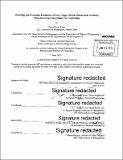Modeling and economic evaluation of early stage clinical monoclonal antibody manufacturing using single use technology
Author(s)
Kress, Daniel Evan
DownloadFull printable version (7.307Mb)
Other Contributors
Leaders for Global Operations Program.
Advisor
J. Christopher Love and Retsef Levi.
Terms of use
Metadata
Show full item recordAbstract
A critical cost driver in the product development process is the manufacturing of clinical trial material supplies. The clinical manufacturing process operates under similar regulatory burdens as commercial biopharmaceutical manufacturing, but must operate with a high degree of flexibility to respond to emerging data from ongoing clinical programs and competitive intelligence. This project investigates the current state of clinical monoclonal antibody (mAb) manufacturing and generates possible future states for low-cost, flexible manufacturing. Pfizer currently has a world-class clinical manufacturing facility in St. Louis, MO, and forecasts have not predicted sufficient growth in the market to justify additional facilities under the current strategy. However, with many other companies turning to single-use technology, Pfizer would like to consider the benefits of a new low-cost, flexible facility for the benefits of flexibility and faster speed to market. A high-level facility model includes capital costs, technical specifications, and a dynamic view of the operational costs based on product attributes. This model shows that a campaign cost of less than $2.6M can be achieved with only 3 projects per year, which represents a facility utilization of less than 40%. At a loading of 4 campaigns per year, this facility would have a payback period of less than 3 years. The conservative facility design shows how capacity can be added with a low operational cost and less than $5M of overhead per year. Business factors such as pipeline prospects and availability of capital may prevent execution of the project in the near term, but investment in single-use equipment is advisable to gain experience in technologies that are likely to play a large part in biopharmaceutical manufacturing in the future.
Description
Thesis: M.B.A., Massachusetts Institute of Technology, Sloan School of Management, 2015. In conjunction with the Leaders for Global Operations Program at MIT. Thesis: S.M., Massachusetts Institute of Technology, Department of Chemical Engineering, 2015. In conjunction with the Leaders for Global Operations Program at MIT. Cataloged from PDF version of thesis. Includes bibliographical references (pages 61-62).
Date issued
2015Department
Leaders for Global Operations Program at MIT; Massachusetts Institute of Technology. Department of Chemical Engineering; Sloan School of ManagementPublisher
Massachusetts Institute of Technology
Keywords
Sloan School of Management., Chemical Engineering., Leaders for Global Operations Program.